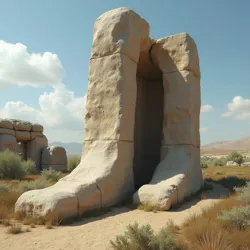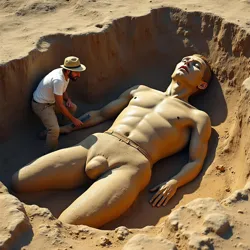Karahan Giant

Partially preserved remains of the Karahan Giant at the archaeological site
1994
Karahan Complex, Turkey
14.2 meters (estimated)
60% intact
Limestone and granite
Late Neolithic
Pre-Halafian civilization
The Karahan Giant represents one of the most significant and well-preserved examples of a Megalithomaton ever discovered. Unearthed in 1994 at the Karahan Complex in southeastern Turkey, this colossal mechanical construct stands as a testament to the remarkable engineering capabilities of the pre-Halafian civilization. The specimen retains approximately 60% of its original structure, including crucial components of its movement mechanism, making it an invaluable source of information about Megalithomaton construction and operation.
Discovery and Excavation
The discovery of the Karahan Giant occurred during the initial survey of the Karahan Complex by a team led by archaeologist Dr. Elena Petrov. The first indication of its presence came from ground-penetrating radar surveys that revealed an unusual geometric pattern beneath the soil. Subsequent excavation work, which spanned nearly a decade, carefully revealed the massive stone construct layer by layer.
The excavation process proved particularly challenging due to the intricate nature of the Giant's mechanical components. The archaeological team employed innovative preservation techniques developed specifically for this project, including the Petrov-Stabilization Method, which allowed for the careful removal of surrounding soil while maintaining the structural integrity of the ancient mechanism.
 Archaeological team carefully excavating the upper torso section of the Karahan Giant in 1997
Archaeological team carefully excavating the upper torso section of the Karahan Giant in 1997Physical Description
Structure and Components
The Karahan Giant stands approximately 14.2 meters tall in its current state, though researchers estimate its original height was closer to 15 meters. The construct is primarily composed of carefully carved limestone blocks, with critical mechanical components crafted from harder granite. The preservation of its internal geometric resonance chambers is particularly remarkable, offering unprecedented insights into Megalithomaton operational principles.
The Giant's torso section contains the best-preserved examples of Stone Activation mechanisms ever discovered, including a complete set of counter-weighted pendulums and water channel networks. These features have provided crucial evidence for understanding how these massive constructs were able to achieve controlled movement.
Mechanical Systems
The most significant aspect of the Karahan Giant is its remarkably intact movement system. The construct retains approximately 75% of its original mechanical components, including a complete network of internal channels that archaeologists believe were used for hydraulic control. The presence of these systems has allowed researchers to develop detailed theories about how Megalithomatons were operated by Stone Priests during ceremonial and defensive activities.
Archaeological Significance
Research Impact
The discovery of the Karahan Giant has revolutionized our understanding of Neolithic engineering capabilities. Its well-preserved state has provided invaluable insights into the sophisticated mechanical knowledge possessed by pre-Halafian societies. The construct has become the primary reference point for all subsequent Megalithomaton research and has led to the development of new archaeological techniques specifically designed for the study of ancient mechanical systems.
Conservation Efforts
Preserving the Karahan Giant presents unique challenges due to its size and mechanical complexity. The Karahan Conservation Initiative, established in 1998, has pioneered new methods for protecting and stabilizing ancient stone mechanisms. These techniques have since been adopted at other Megalithomaton sites across the region, including the Yammuneh Installation.
Cultural Context
Religious Significance
The Karahan Giant appears to have held particular religious importance within the pre-Halafian community. Carved symbols found on its surface match those discovered in nearby temple complexes, suggesting it played a central role in religious ceremonies. The positioning of the Giant in relation to astronomical alignments indicates it may have served as both a defensive structure and a ceremonial timekeeper.
Social Organization
The construction and maintenance of the Karahan Giant would have required an extremely sophisticated level of social organization. Evidence suggests that specialized groups within the society were responsible for different aspects of its operation, from the Stone Priests who controlled its movements to the engineers who maintained its mechanical systems.
Modern Analysis
Engineering Studies
Contemporary engineering analysis of the Karahan Giant has revealed sophisticated mechanical principles that weren't "rediscovered" until thousands of years later. The precision of its stone joints and the efficiency of its movement systems have inspired modern architects and engineers, particularly in the field of sustainable building design.
Digital Documentation
Using advanced 3D scanning and modeling techniques, researchers have created detailed digital reconstructions of the Karahan Giant. These models have allowed for in-depth analysis of its mechanical systems and have helped identify previously unknown features of its design. The Digital Megalithomaton Project maintains an extensive database of these scans, which continue to yield new insights into ancient engineering practices.
Legacy
The Karahan Giant remains one of the most important archaeological discoveries of the late 20th century. Its study has spawned numerous academic fields and continues to challenge our understanding of prehistoric technological capabilities. The site has become a crucial center for archaeological research and has attracted scholars from around the world studying ancient mechanical systems and early engineering practices.